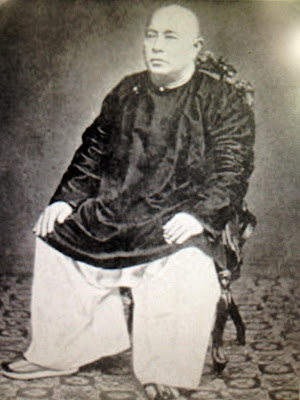Chia Ann Siang, born in Malacca (1832-1892) was born from a wealthy Chinese sawmill family-owned business. Being underpaid and under appreciated, he left for better opportunities, to join the British firm Boustead and Company in 1848, that was situated in Singapore at that time. He wanted to know more about international trading because it is a new exploration in his career. The company traded in natural resources, coconut, tobacco, tin tea, spices and silk.
 |
| Chia Ann Siang |
|
|
|
.JPG) |
| Chia Teck Sian, 4th son of CAS |
.JPG) |
| Wife of Chia Teck Sian |
 |
| My Grandpa (CAS grandson) and Grandma |
Ann Siang Hill, located off South Bridge Road, was the site of the house and
estate of
Chia Ann Siang (谢安祥; 1832–1892), a wealthy
Malacca-born
Hokkien Chinese sawmiller. Chia joined
British firm Boustead and Company in 1848. The company traded in
natural resources,
spices,
coconut,
tobacco,
tin,
tea and
silk. Boustead's
ships plied the
China-
Europe
routes in the early days. After eight years on the job, Chia was
promoted to chief produce storekeeper. He retired in 1890 after over 40
years of service in the company, and went into the
timber
business. He also became a partner of the firm Geok Teat and Company in
1863. After he became a wealthy landowner and one of the leading
merchants of his time, he acquired both Ann Siang Hill and
Mount Erskine.
Before Chia bought the area, the hill was known as Gemmill's Hill after
John Gemmill, a merchant and former
auctioneer, and before that Scott's Hill, after its original owner
Charles Scott, who cultivated
nutmegs and
cloves in the area.
The foot of the area between Ann Siang Hill and Mount Erskine, where South Bridge Road meets
Neil Road and
Tanjong Pagar Road (the site of the
Metropole Theatre, now the
Fairfield Methodist Church), was one of the earliest
Cantonese Chinese
burial grounds. The graveyard was in use up to 1867, exhumed in 1907 and part of the area, together with
Mount Wallich, used for the
Telok Ayer reclamation project.
The Chinese used to call this area
qing shan ting. The early
Chinese immigrants visited Ann Siang Hill when they wanted to send money
home to their families in China, as it was the traditional site of
remittance houses. Letter writers and calligraphers also had their businesses at the
five-foot way of the
shophouses to help the illiterate immigrants write letters home.
Most of the houses in Ann Siang Hill and along Ann Siang Road were
built between 1903 and 1941. Ann Siang Road, which has elegantly
restored shophouses today, was once the traditional home of
clan associations and exclusive social
clubs.


